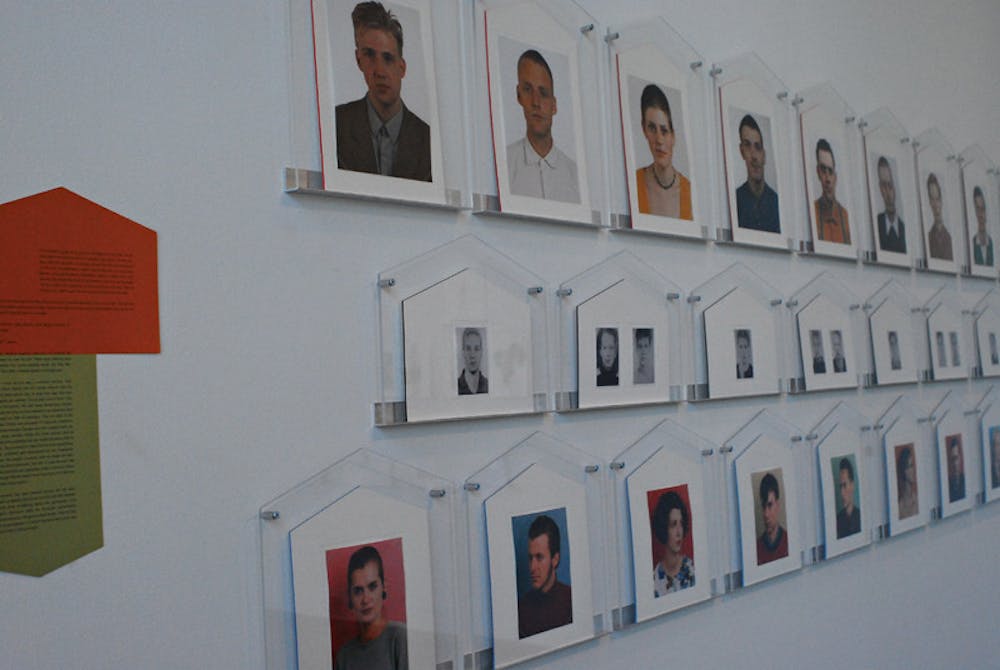The watery blue of a bright sky recedes behind lush gardens and asphalt highways. Strangely intense faces look forward and sideways — both watching and ignoring you. Stories and thoughts travel in wide arcs and boxy texts, in Spanish, French, German and English.
The Creative Arts Council displays these works at its exhibition “Toluca Editions: 6 Projects,” running through Oct. 18 in the Cohen Gallery at the Perry and Marty Granoff Center for the Creative Arts.
“Toluca Editions” are original pieces from a Paris publishing house founded 10 years ago by Alexis Fabry and Olivier Andreotti, said Director of the Creative Arts Council Richard Fishman. Fabry and Andreotti started out as book publishers who presented important work on contemporary photography. Fishman added that Fabry and Andreotti chose six artists they admired for the exhibit.
Inside the gallery, each piece has been created through the collaborative efforts of an artist, a writer and an industrial designer. According to the readings at the exhibition, each collaboration, or “hybrid art object,” is considered an “artist’s book,” including photographic images, text and a decorated box.
Each industrial designer’s decorated case is placed in one of six glass displays in front of the gallery’s windows and corresponds to a work of art presented in the room.
“Every Toluca project is more than a project bringing together a fine artist, industrial designer and literary artist. It is the passionate end result of Alexis Fabry’s desire to elevate the book to a precious art object,” wrote Steven Perelman ’90, member of the board of governors of the Rhode Island Institute of Design Museum, in an email to The Herald.
The exhibit shows that everyone interprets art — paintings, portraits, photographs and stories — in different ways. People’s reactions to images and words are shaped by their own experiences. In “What Man Is Really Like,” German writer Ingo Shulze describes the life of his alcoholic friend Andreas in Berlin. The melancholy of Andreas’ life can be seen in Turner Prize winner Rachel Whiteread’s photographs of battered cardboard boxes left on dirty deserted streets. The simplicity of such sadness is then traced in Japanese designer Naoto Fukasawa’s carefully crafted wooden casing.
“Morgues,” five photographs taken by Andres Serrano, unflinchingly depict the corpses of both men and women. According to the gallery reading, Serrano believes the focus of these photographs is life, not death. “To me they are very present, almost alive. There’s a strong, natural force that comes forth in this series — its skin breathes,” he wrote in the reading.
Black paintings of skirts swing beside the pictures, their silhouettes conjuring up images of pumping aortas and ventricles. Finnish designer Harri Koskinen’s container is made of stainless steel, reminiscent of the metal morgue tables that display the lifeless bodies. Mexican writer Mario Bellatin’s perspective on humanity from the view of a podiatrist’s magnifying glass finishes off the work. All three element of the display come together like pieces of a giant puzzle to address the peculiarities of mortality in innovative ways.
The exhibit’s themes include love, death, loneliness, paranoia and greed, threads that are strung together through endless loops. The themes are distorted and reworked through the lenses of the artists, whose own histories influence the way they react to heartbreak, violence and childhood nostalgia. Shulze sees his lonely friend Andreas while Whiteread sees the inherent sorrow of crushed boxes on a gray street. They both evoke an unnerving sense of despondency.
“I liked the connection between the visual and the text. They all mixed well together,” said Paula Abarca ’17.
Fishman said he hoped students would see the value of artists working collaboratively at the highest caliber.
“The principles on which Toluca was founded are similar to the Open Curriculum because of its interdisciplinary nature,” he added. “You have to choose a writer, artist and designer to come together and form a cohesive element.”
Perelman agreed — “Exposing Brown students to that passion and creativity is what is most important to me,” he wrote.
He wrote that both he and Fishman have visited art galleries in New York City, including Josee Bienvenu Gallery, “the exclusive representative of Toluca Editions.”
“The most challenging parts of presenting this exhibition were the logistics of bringing the principals and the materials of Toluca from Paris to Providence. (But) with instant communication and international travel, that wasn’t very challenging,” wrote Perelman. He added that Fishman’s “desire not only to foster continued interdisciplinary learning among Brown’s various concentrations but also to explore opportunities for students at both Brown and RISD to learn together” influenced Perelman’s desire to bring “Toluca Editions” to Fishman’s attention.
Fishman said the exhibit has inspired a jointly taught Brown-RISD course — “Built Thoughts: Collaborative Theory and Practice,” which will be offered next semester and require students to work in groups to produce their own portfolios. Professor of Literary Arts and Department Chair Cole Swensen will teach the course with RISD faculty members Thomas Wedell, from the department of graphic design, and Khipra Nichols, from the department of industrial design.
“I look forward to hearing and seeing the community’s response to the exhibition, what develops in terms (of) educational opportunities and then whether there is an exhibition of student work product at Josee Bienvenu Gallery in New York City,” Perelman wrote.

ADVERTISEMENT




